“The Brown setting is the closest you’ll get to playing one of Eddie Van Halen’s Super Leads – at least in a pedal”: UAFX Lion ’68 Super Lead Amp review
The Lion’s ability to replicate the attitude, pureness of tone and touch responsiveness of vintage Marshalls, and then combine it all with emulations of the right speakers and cabs, makes it one impressive package
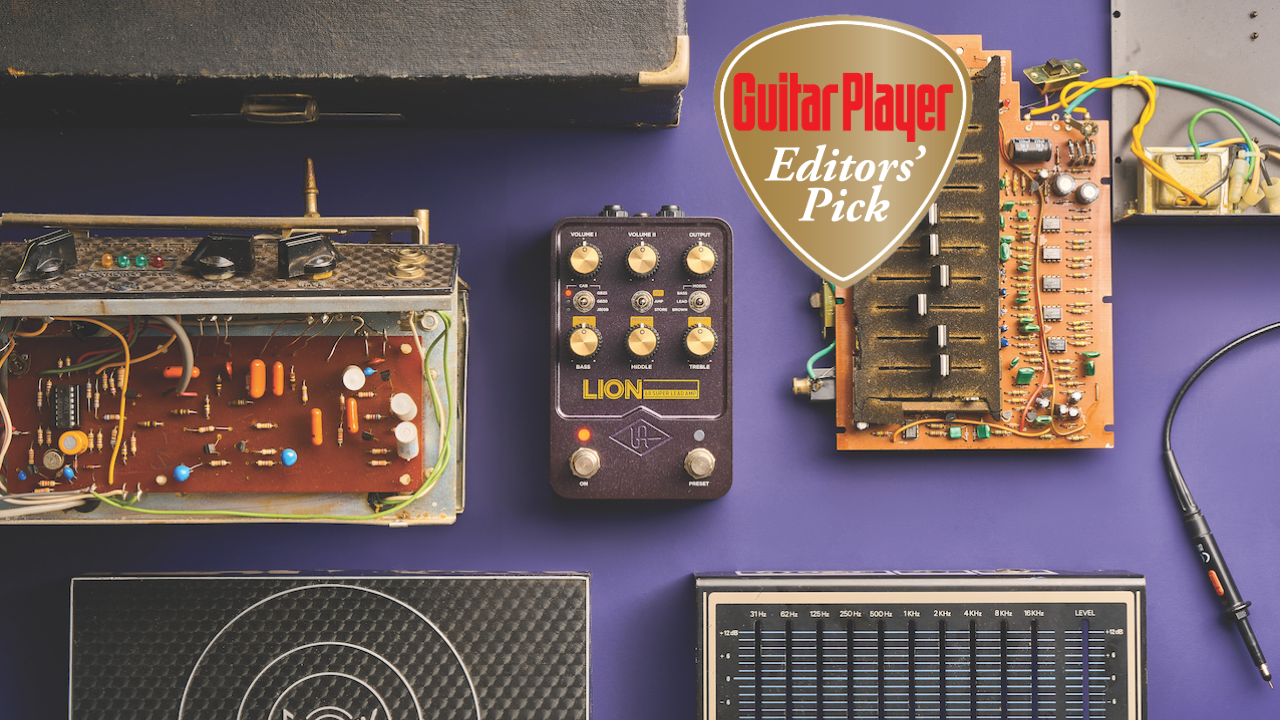
The latest amp-emulator pedal from UAFX offers three models from a stable of 1968 100-watt Marshalls: the Super Lead, Super Bass, and Brown.
The Brown is an exclusive setting that emulates a Super Lead with a Variac auto-transformer in line to lower the voltage in order to achieve the famed EVH “brown sound.” The Lion’s mission is to give players the ability to deploy the best-sounding vintage Marshalls and top it off with classic mic/speaker pairings, boosts, and mods to provide produced-sounding tones without the hassle of setting up all the gear required to get there.
Since the UAFX team went to the trouble of sourcing exceptional amplifiers to emulate in the digital domain, it’s worth understanding how they differ. The 1968 Marshall Super Bass amp dispensed with a bright cap in order to give it a slightly darker crunch when overdriven. Presumably to enhance headroom (and by virtue make it great with pedals), the UAFX version emulates an amplifier running at 117 volts.
The 1968 Marshall Super Lead is brighter and has more gain. The UAFX version is the amp running at 110 volts and configured with a 100pF bright cap – as used in the earlier JTM 45 amplifier – instead of the stock 5,000pF cap. This allows for top-end jangle without the harshness of the original cap. The bright cap can be removed via the UAFX Control mobile app.
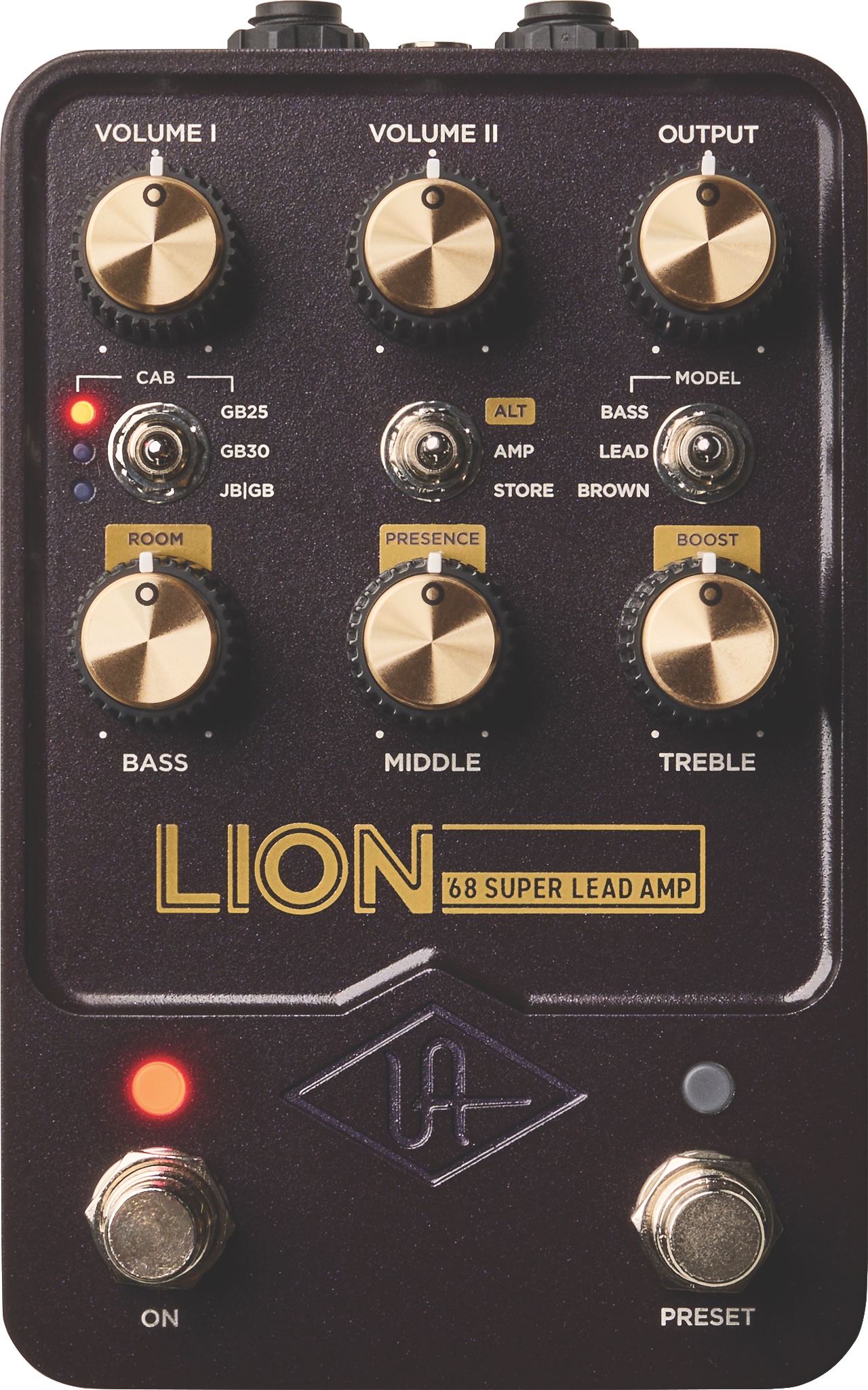
Brown emulates a Super Lead running at 90 volts for more sag and thickness, and biased high to deliver an aggressive attack with more compression and sustain. The bright cap is removed here but can be activated in the app.
Although the Lion is a totally new design, its functionality is similar to the other UAFX pedals that use the same size enclosure (3.6 x 5.5 x 2.5 inches). Performance features include dual-engine processing, stereo inputs and outputs (the upper jacks are used for mono connections), USB-C for loading firmware updates and accessing bonus speakers via the UA Connect computer app, and a Bluetooth button for connecting to the UAFX Control mobile app (iOS and Android).
The app allows you to manage presets and edit global settings, such as foot-switch modes, input routing, and noise gate and bright cap activation.
Get The Pick Newsletter
All the latest guitar news, interviews, lessons, reviews, deals and more, direct to your inbox!
Operationally, the Lion is easy to use. Across the top are volume 1, volume II and output knobs (appropriately, the knobs are in the old Marshall style).
The channels are internally jumpered, and you can choose via the Control app to have the low or high inputs Y-cabled together or use the more common configuration of plugging a guitar into the high input of channel I and running a jumper cable between the low input of channel I and the high input of channel II. It’s worth trying these hookups because they do sound a bit different.
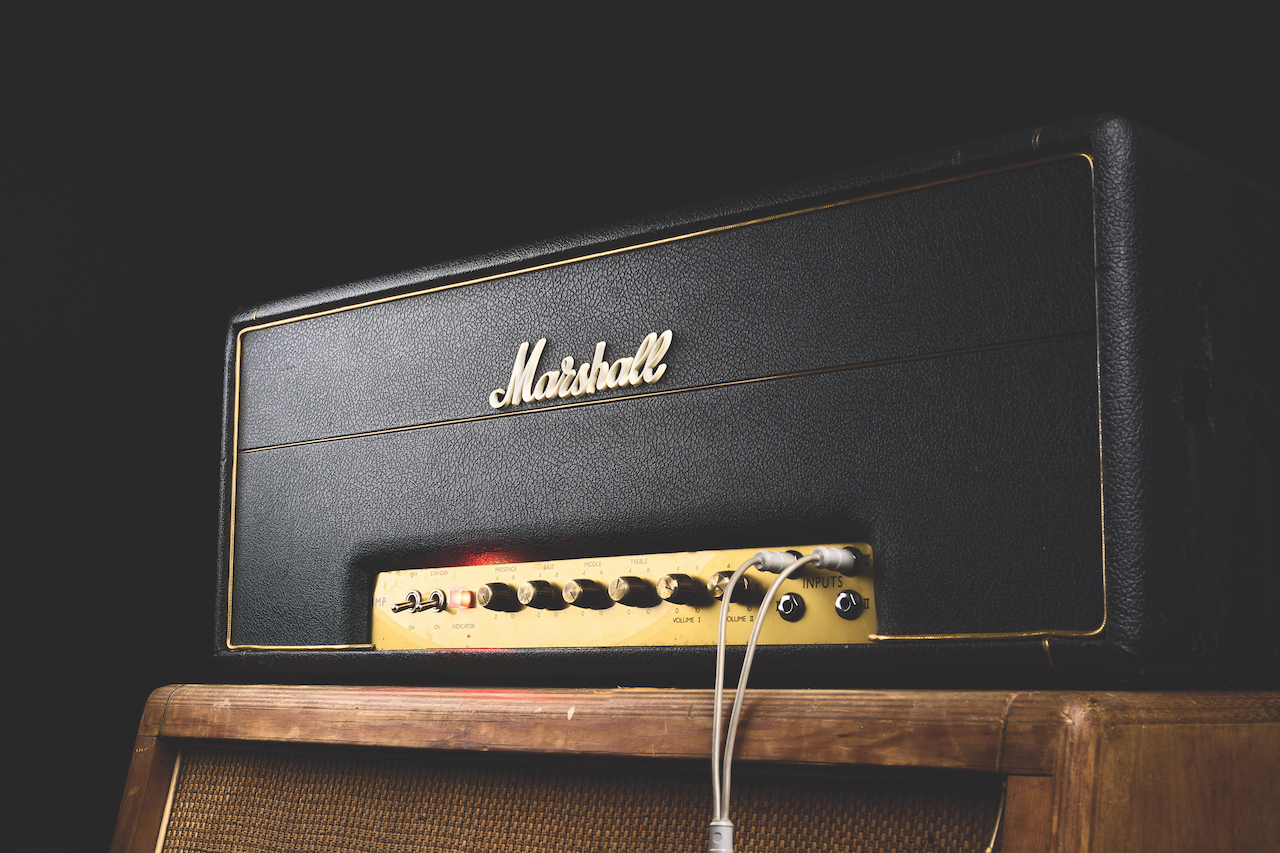
Next in line are three toggle switches. Cab is a three-position switch that cycles through GB25, GB30 and a mixed pairing of JB and GB speakers (i.e. JBL D-120F and Celestion Greenbacks). Pressing the switch repeatedly in the same direction cycles through all available cabs.
The LED by each selection glows red when the cabinet that’s printed on the pedal is active and green when the bonus cabs (available upon registration) are selected. When an LED is off it means the amp is active but the cabinet simulation is disabled.
Following are ALT toggle (activates Room, presence and boost functions on the bass, middle, and treble knobs) and the all-important Model toggle, which has settings for Bass (1968 Super Bass), Lead (1968 Super Lead), and Brown (Super Lead with Variac power reduction, EQ pedal, and EP-III preamp boost).
As previously noted, the bottom row of knobs are dual function: Room/bass adds studio ambience and air; bass adjusts low frequencies. Presence/middle adds high-end sparkle and gain; middle adjusts mid frequencies. Boost/treble adds gain, EQ and color to the preamp boost (zero boost when turned fully counter-clockwise); treble adjusts high frequencies.
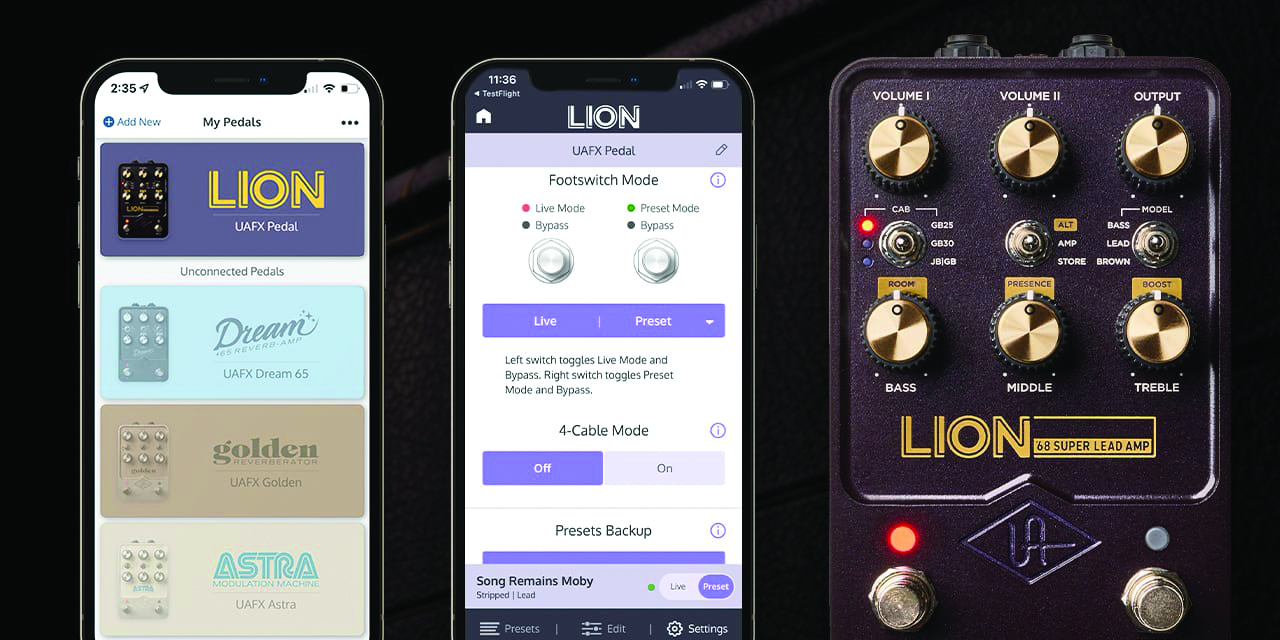
The left foot switch toggles Live mode on/off, and the LED is lit when knob settings are active. The right foot switch toggles Preset mode on/off, and the LED is lit when stored settings are active (you hear the settings that are stored as a preset, and the current positions of the knobs and switches do not reflect the sound).
You can store a preset created with your own settings (or artist and factory presets available via the UAFX Control app) by holding down the store switch (which is on the ALT toggle) until the green Preset LED blinks rapidly.
You can also change the foot-switch assignments via the app to have the left switch activate boost on/off and the right switch toggle between Live and Preset modes. Lastly, activating 4-Cable mode lets you switch between the preamp in your amplifier and the pedal, effectively adding an extra channel to any amp with an effects loop.
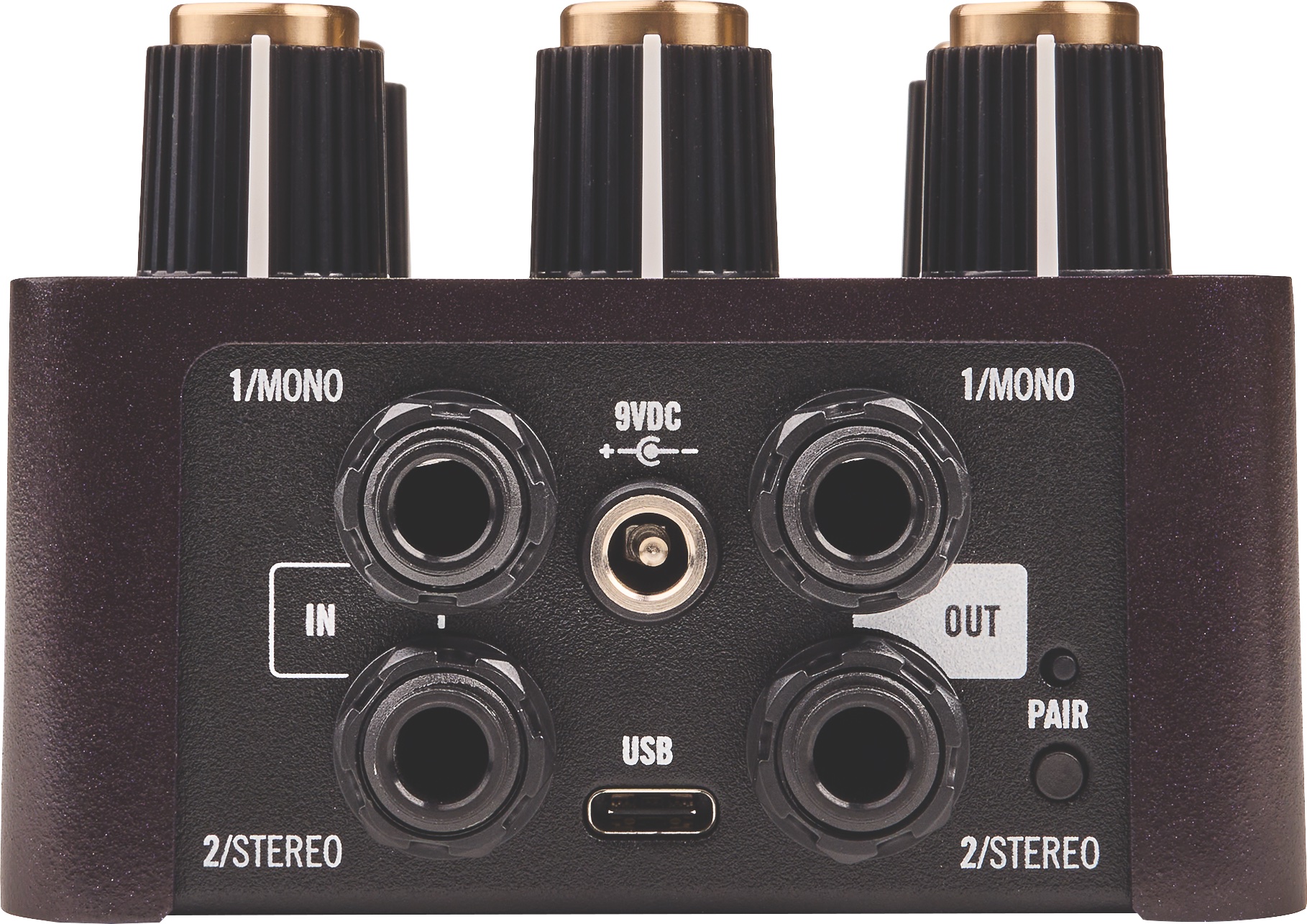
The cabinet selections provide a lot of ways to shape tones, with the stock settings offering these configurations:
• GB25 1968 4x12 cab with 25-watt Celestion Greenbacks, miked with a Beyerdynamic 160 and a Shure SM57.
• GB30 4x12 with Celestion 30-watt Greenbacks, miked with a share SM57 and
a Royer R-121.
• JB/GB 1968 4x12 with two 30-watt Celestion Greenbacks and two JBL D-120Fs, miked separately with SM57s and premixed.
The same switch positions activate these bonus speaker configurations:
• GB25 12-inch, 200-watt Electro-Voice EVM12L in a 1x12 cabinet, miked with an AKG 414.
• GB30 Ported 2x12 cabinet with British 65-watt speakers, miked with a Sennheiser 421 and a Royer R-121.
• JB/GB 4x12 cabinet with Celestion V30 speakers, miked with an AKG 414.
The Lion delivers convincing Marshall tones. The only thing missing is the smell of hot tubes in an old head
Auditioned through studio monitors and headphones, the cabinets provided many ways to shape sounds, and being able to add the ambient room sound is a plus for tracking or in a rig with full-range speakers.
The emulations of a 1968 4x12 cab with 25-watt Celestions or the combination of Celestion and JBL speakers covered the bases quite well, and the alternate choices – such as the 2x12 cab with “British” (read: Celestion) 65-watt speakers or the 4x12 with Celestion V30s – were equally capable of delivering stout rock tones.
Considering the top-notch amp and effect emulations we’ve heard in other UAFX pedals, it’s no surprise that Lion delivers convincing Marshall tones with any of these cabinets. Perhaps the only thing missing is the smell of hot tubes in an old head.
Even with standard guitar amps, Lion performed admirably as a distortion pedal. Straight into a Fender Deluxe Reverb or ’48 Dual Professional set clean, and with the cab simulation disabled, it was easy to dial in happening tones by turning up the volume I and II knobs for the desired level of grind and treble/bass balance and tweaking the tone and presence controls to suit guitars that included a ’63 Les Paul Junior, a PRS SE Special, and an Epiphone Joe Bonamassa 1963 SG Custom.
With its ballsy presence and smooth top, the Brown setting delivers killer saturated grind that’s aggressive and heavy, yet can pull back to a fat, loose, clean tone when the guitar is rolled down.
This emulation of an EP-III–boosted Marshall is the bomb here. Biased to take advantage of a lowered wall voltage, for more sag and compression, it’s totally worth the price of admission. It’s the closest you’ll get to playing one of Eddie Van Halen’s Super Leads – at least in a pedal.
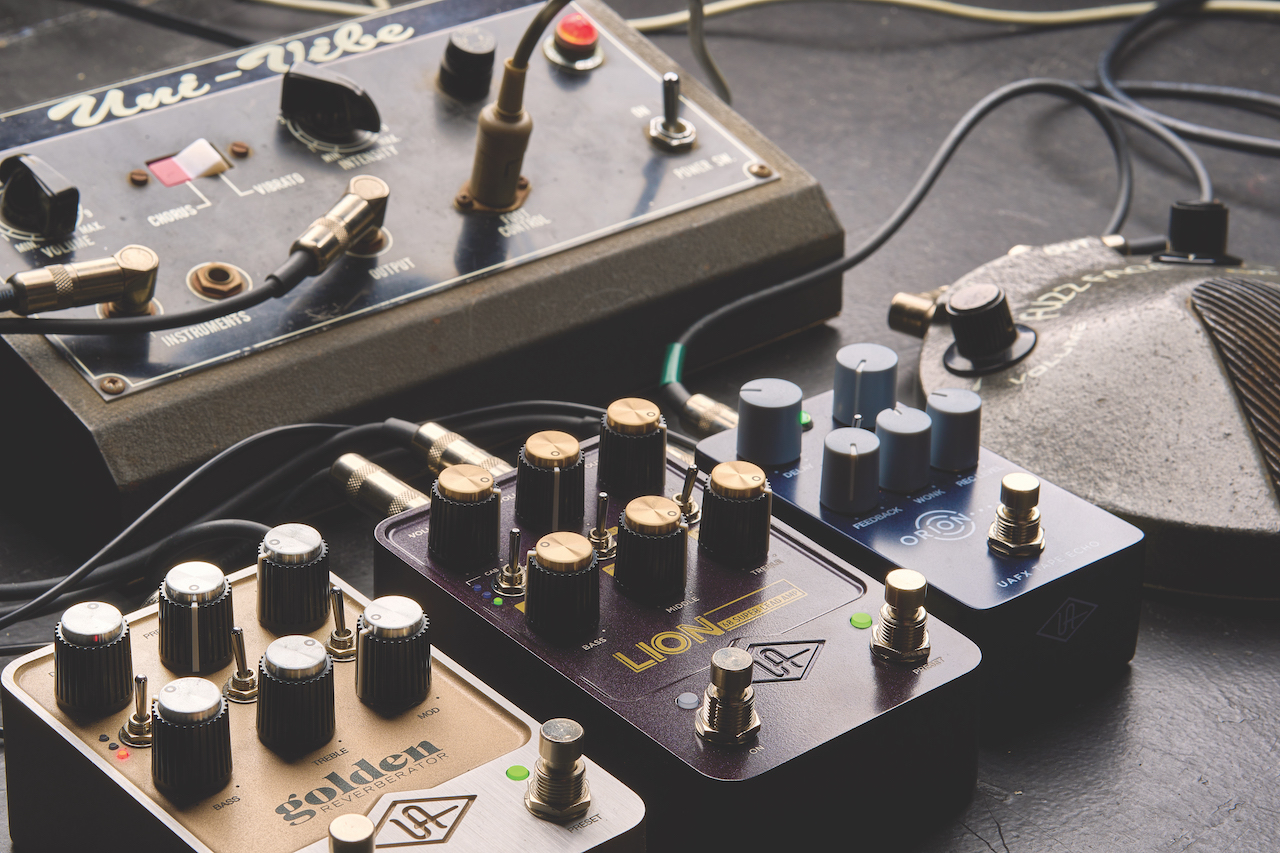
The convenience is unreal, too. By configuring Brown on the left foot switch and either the Super Bass or Super Lead as a preset for lead or rhythm on the right-hand foot switch, it was really easy to use Lion live. Another good option is to toggle between Brown and either of the other Marshalls with the right foot switch and deploy the left switch to activate a boost.
These amps are all very different – particularly in how the Super Lead and Super Bass are respectively brighter and higher gain, or rounder and less gainy – but they all sounded great with pedals, which included a TWA SH9, an EHX Lizard Queen Octave Fuzz, and a UAFX Orion Tape Echo.
Lion’s ability to replicate the attitude, pureness of tone and touch responsiveness of vintage Marshalls and then combine it all with emulations of the right speakers and cabs, makes it one impressive package. To be able to put that kind of firepower in your pocket is the best thing since Jim Marshall introduced the amp top and 4x12 bottom. For everything it does, Lion gets an Editors’ Pick Award.
Specifications
UAFX Lion ’68 Super Lead Amp
CONTACT Universal Audio
PRICE $399
CONTROLS Volume I, volume II, output, Room/bass (adds studio ambience and air; bass adjust low frequencies), presence/middle (adds high-end sparkle and gain; middle adjust mid frequencies), boost/treble (adds gain, EQ and color to preamp boost; no boost when fully counter-clockwise. Treble adjusts high frequencies)
SWITCHES Cab (cycles through available speakers. When LED is off amp is active but cab is disabled), ALT (activates room, presence and boost controls on the bass, middle and treble knobs), Model (Bass is a 1968 100-watt Super Bass amp; Lead is a 1968 100-watt Super Lead amp; Brown is a 100-watt Super Lead with Variac’d power reduction, circuit mod and EQ’d boost
FOOT SWITCHES On toggles amp on/off; LED lit when knob settings are active. Preset on/off; LED is lit when stored settings are active
I/O Stereo inputs and outputs, USB Type-C (connect to computer for firmware updates via UA Connect desktop app), 9VDC adapter jack (400mA, not included), pair button for Bluetooth discovery
EXTRAS Alternate foot-switch modes and other features available via UAFX Control mobile app (iOS and Android)
SIZE 3.6” x 5.5” x 2.5” (DxWxT)
WEIGHT 1.28 lbs
BUILT Malaysia
KUDOS Awesome vintage Marshall tones. Wide variety of miked-speaker selections with variable room sound. Easy management of custom presets
CONCERNS None

Art Thompson is Senior Editor of Guitar Player magazine. He has authored stories with numerous guitar greats including B.B. King, Prince and Scotty Moore and interviewed gear innovators such as Paul Reed Smith, Randall Smith and Gary Kramer. He also wrote the first book on vintage effects pedals, Stompbox. Art's busy performance schedule with three stylistically diverse groups provides ample opportunity to test-drive new guitars, amps and effects, many of which are featured in the pages of GP.
"The only thing missing is the noise from the tape loop." We review the Strymon EC-1 Single Head dTape Echo, a convincing take on a very special vintage tube Echoplex
"BigSky MX will be replacing the BigSky as my go-to reverb pedal. I’ve heard nothing that covers all the bases with such pristine and detailed audio quality." We crowned the Strymon BigSky MX the champ of multi-reverb pedals











